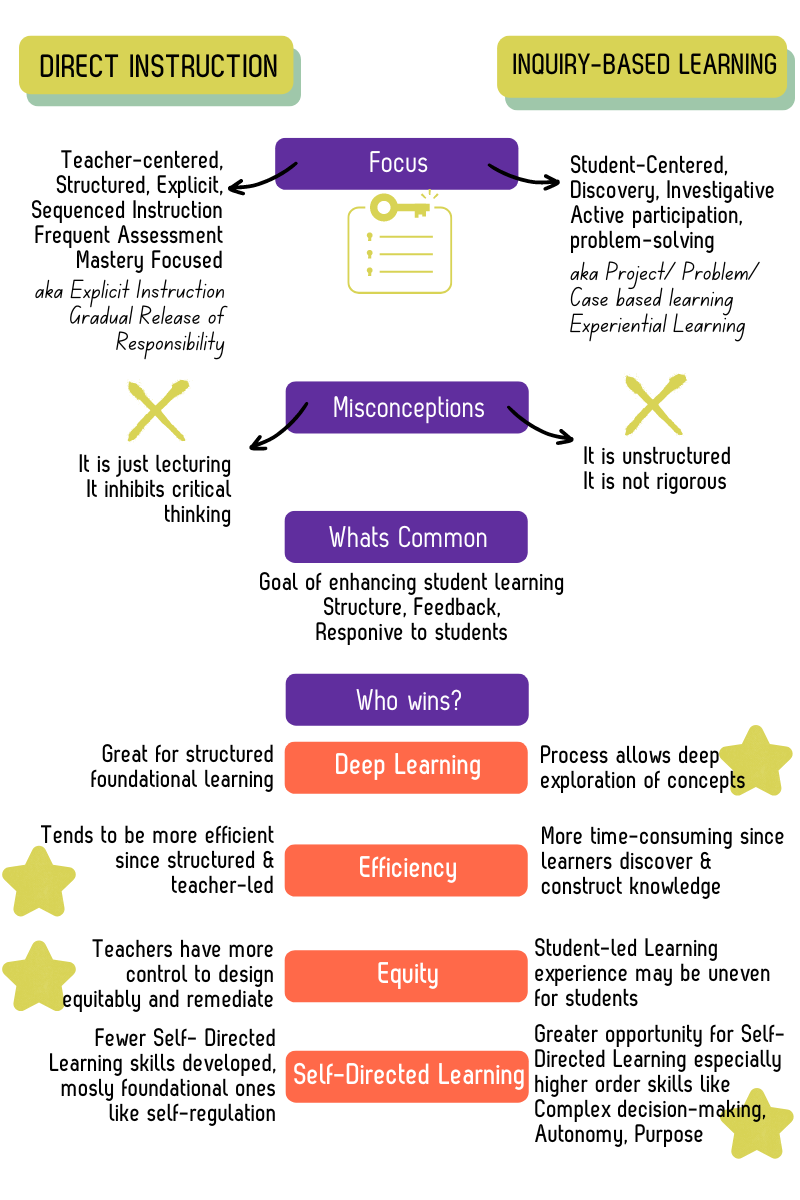Inquiry-based OR Direct-Instruction? Please don’t pick a side.
Why we need and should love a good mix of both!
The Idea:
Students benefit from both, Direct Instruction and Inquiry.
They don’t have to be mutually exclusive.
Direct Instruction enables strong knowledge foundations, efficient pace of learning and greater equity. Inquiry nurtures deeper, conceptual understanding through construction of knowledge through social interactions and exploration of the environment, practical skill building and self-direction.
Here are broad recommendations on how to balance them:
1) Purpose: Choose inquiry for deep, conceptual or more complex learning. Choose Direct Instruction for more efficient, structured/foundational learning.
2) Equitable learning: Prior knowledge, foundational inquiry skills, self-regulation, foundational literacies like math, language literacy are essential for Inquiry methods. Choose Direct instruction to differentiate/ scaffold learning or remediation in such situations for more equitable learning.
One of the best papers I read this year was Let's talk evidence – The case for combining inquiry-based and direct instruction. I admit I am highly susceptible to confirmation bias here, because I have been making this case (from practical experience, not evidence) for many years now. Here’s a response Response to De Jong et al.’s (2023) paper “Let's talk evidence – The case for combining inquiry-based and direct instruction” that critiques their lack of theoretical grounding and methodological flaws, yet agrees on the importance of explicit instruction, proposing its integration based on cognitive theories.
I will note my important takeaways in this post:
What is Direct Instruction?
Direct instruction is a teacher-centered approach where concepts and skills are explicitly taught through structured, sequenced lessons and demonstrations. This method emphasizes clarity, pacing, and frequent assessment to ensure student understanding and mastery of the material.
What is Inquiry-based learning?
Inquiry-based learning is a student-centered approach where learners actively participate in the process of exploring and investigating, leading to the construction of knowledge. It emphasizes critical thinking, problem-solving, and the ability to use evidence to draw conclusions, often involving experiments or real-world problem scenarios. This method fosters deep understanding and engagement by allowing students to explore questions and challenges that are meaningful to them.
Of course the pedagogy of Direct Instruction and Inquiry-based Learning has much more depth to it, something that I cannot cover in this post.
A Comparison of Direct Instruction and Inquiry Learning:
Recommendations from the paper
Use Purposefully: Employ direct instruction for foundational knowledge and facts, which provides students with the necessary background to engage in more complex, inquiry-based learning effectively. Most often, direct instruction can be used to introduce key concepts and procedures initially, followed by inquiry-based activities that allow students to explore these concepts deeply.
Plan Guidance and Scaffolding: Integrate guided inquiry within the learning process, where direct instruction provides the necessary scaffolding to support the inquiry activities. This scaffolding can be adjusted based on student needs, ensuring that students are neither overwhelmed nor under-challenged.
Adapt Support Based on Student Needs: Differentiate and personalize instruction based on students’ prior knowledge and current self-directed learning abilities. This may involve providing more structured direct instruction to some students while others engage in open inquiry.
Blended Learning Environments: Create learning environments that blend both direct and inquiry-based instructions, using technology where appropriate to support and enhance the learning process. This blend can help address various learning preferences and needs, making the learning experience more inclusive.
Feedback and Reflection: Incorporate continuous feedback and opportunities for reflection within both instructional methods. Feedback can be derived from direct instructional methods and applied to enhance the inquiry process, helping students understand their learning progress and areas for improvement.
A personal reflection
When I did my Masters Degree at Teachers College in 2008, we explored heavily constructivist pedagogy only and it blew my mind. I strongly believed that Inquiry-based learning was the only way for students in the 21st Century.
Before this, I had mistakenly interpreted my own schooling experiences (in a very large Catholic SSC school) to be ‘Direct Instruction’, which I now know is not true. That was just old school pedagogy.
On my return to India, I taught the IB Curriculum in an International School. I tried to apply inquiry approaches and had good success. My kids were engaged and curious, learning real-world skills in my math class. I was a novice and moderately skilled teacher at the time, but since I had only 20 students in a class it was manageable.
However, in other school contexts, meaningful inquiry-based learning seemed to disastrous. This was mostly because 1) There were a large number of students and/or 2) Students came in with a wide difference in foundational skills and/ or 3) Students did not possess key foundational skills (language, math, self-regulation) to sustain inquiry-based tasks.
I found myself leaning more on pedagogy closer to direct instruction i.e. more structured and explicit instruction when I was teaching students with big learning gaps in a Municipal school and in my school for students with special needs. This also felt true in classrooms with 40 students. Honestly, this is where I truly discovered how wonderful Direct Instruction (Explicit Instruction, Gradual Release of Responsibility) was. I was ignorant before and had big misconceptions about what it was.
8 years into teaching in a variety of contexts, I realise that both are essential and must be used flexibly in todays 21st Century in schools. Purposefully combined, based on the context. I believe if educators truly understood each approach, they would see this clearly and there would be no debate about which one we should be exclusively marrying.



I agree both inquiry -based and direct instructions are needed to achieve the goal.Sometimes you need to use both and sometimes only one is needed depending on the depth of the content and learning environment as well as the learning experience of the learners.
It's not either/or, both the strategies are equally important in the learning and teaching process.